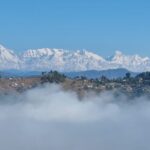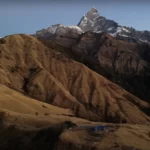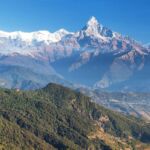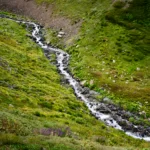Having been born and brought up in the gateway city of North East India – Guwahati still evokes images of the mighty Brahmaputra river meandering through much of the city and of those joyful days when as kids, we would play beach cricket on the sandy stretches of the river bank every winter. There was also a wild side to this river in that with the onset of the monsoon season, the river’s fury and turbulence would inundate large parts of the state of Assam, flooding almost all the riverside towns. The perennial problem of flooding the Brahmaputra valley continues unabated despite the best efforts of the conservation authorities.
The Length of The Brahmaputra River
The Brahmaputra River is no ordinary river, and based on the length of the river (2,900 Km), it is one of Asia’s principal rivers and perhaps the most turbulent.
Origin of The Brahmaputra River
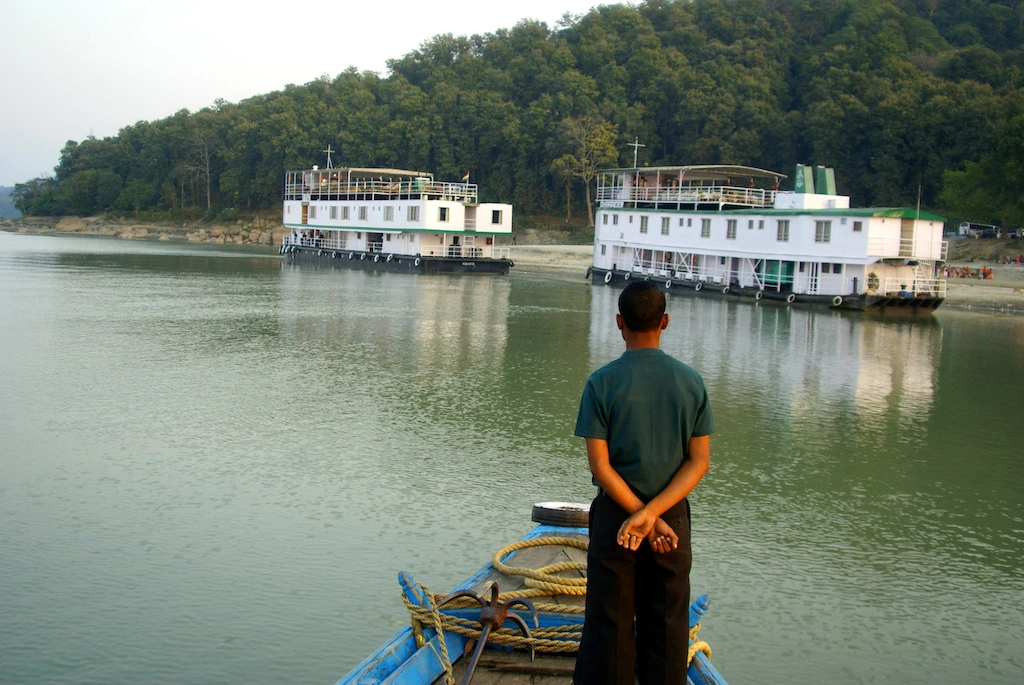
It originates from the icy glaciers of the Himalayas, passes through much of Tibet, the North Eastern states of Arunachal Pradesh and Assam and finally merges with the holy river Ganga and empties into the Bay of Bengal.
When it passes through Tibet, the river is known as the Yarlung Zangbo River. The stretch of the river as it passes through the mountainous state of Arunachal Pradesh is called the Dihang River. When it merges with the Ganga, it shapes up the Sunderban Delta, the world’s largest riverine delta that has been the exclusive preserve of the rare and endangered Royal Bengal Tigers for centuries.
The Brahmaputra is a mythological river, and an important facet of this river is that while most rivers in India and elsewhere in the world are regarded as female, this river stands out as the only male river in the world. The word “Brahmaputra” literally means “son of Lord Brahma”.
The Untapped Potential of River Brahmaputra
For decades together, the mandarins of the Indian Tourism industry have pondered the pros and cons of harnessing the true potential of the river Brahmaputra to attract tourists. But nothing much materialized. For years, adventurous rafters from distant corners of the world (USA, UK, Germany) would come with all their logistics and embark on white water rafting, particularly on the lower reaches of the river where the turbulent rapids are ideal for river rafting with very little co-operation from the local government.
Assam Bengal Navigation Company
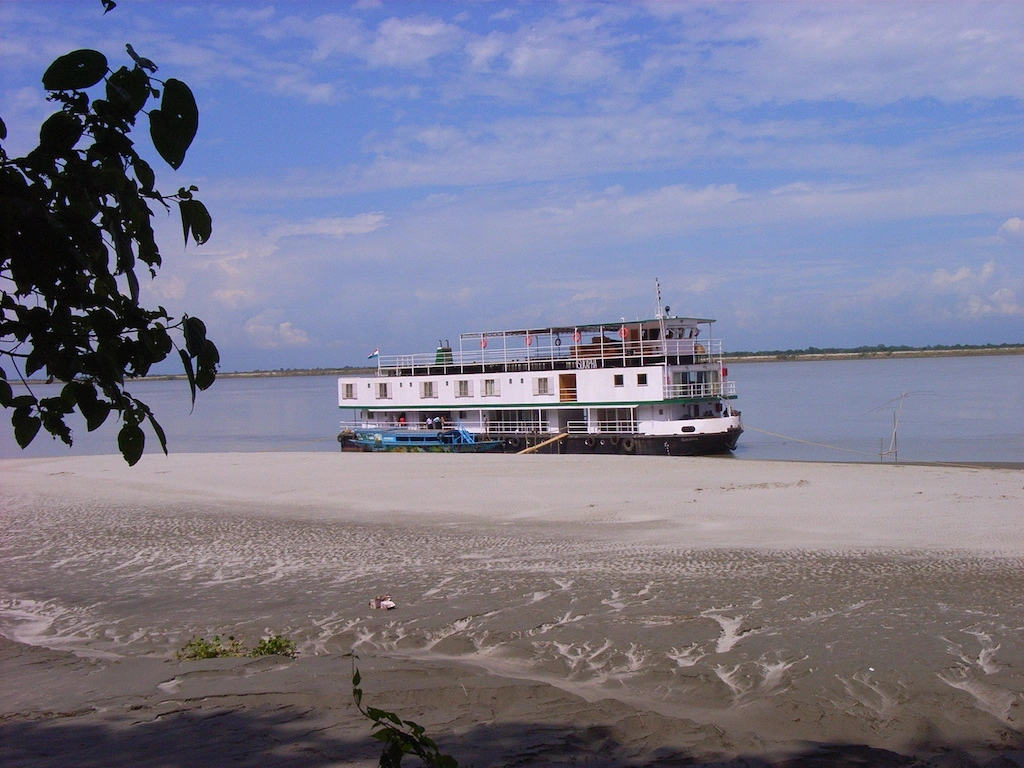
However, all these deadlocks were brushed aside with the launch of the Assam Bengal Navigation Company in the year 2003, which is an Indo-British joint venture. They started operating high-quality river cruises in the Brahmaputra River and the river Hugli in the neighbouring state of West Bengal, earning accolades from the Tourism industry.
One of the finest moments in the history of North East India’s sagging Tourism industry was when the Ministry of Tourism, Government of India, conferred the most coveted “National Tourism Award for Innovation” in 2004-05 to the Assam Bengal Navigation Company. From then onwards, there has been no looking back. The ABNC has gone from strength to strength with offices in India and countries like the UK, USA, Australia, Canada, Netherlands, New Zealand, Sweden, Germany, France and Italy, where they receive the lion’s share of cruise bookings.
Embarking on a 10 Night cruise on the River Brahmaputra
As a Travel Writer, I was offered the rare privilege of embarking on a 10 Night cruise covering the colonial town of Dibrugarh, the medieval Ahom capital of Sibsagar, the island of Majuli, the world-famous Kaziranga National Park, the ancient city of Tezpur and the mecca of Assam’s burgeoning Silk industry – Sualkochi.
Before I take you on the roller coaster cruise along the river, it is apt to mention that the Brahmaputra, along with the Ganga (Ganges) and Hugli rivers, used to be the vital transportation channels of the British East India Company. However, with the partition of 1947 and the emergence of the railways, this fascinating water transport mode was laid to the back burner.
After an overnight train journey from Guwahati, I reached Dibrugarh town and was escorted to a waiting cab by one of the Assam Bengal Navigation Company representatives. A brisk 3.5-hour drive past quaint Assamese countryside and lush green tea gardens brought us to the Neamati Ghat jetty, where the magnificent vessel “Charaidew” was moored.
In another half an hour, the Charaidew began its long voyage to Guwahati, and like all long-distance cruises, there was excitement in the air. A group of visitors from the UK, IT professionals, two NRI families, and the crew made up the party.
As the vessel meandered its way through the river, I sat on the sundeck with a beer can accompanied by a guest from the UK who revealed that he was undertaking the voyage to rekindle the memories of his grandfather who had worked in a renowned Tea Garden of Assam and passed away soon after the 1947 partition. He had the address of the graveyard where his grandfather was buried, and the ever-friendly ABNC staff had promised to take him there so that he could pay his homage to his ancestors.
As the luxury vessel cruised along, the fascinating riverside views dotted with charming Assamese villages and the appearance of small towns made for a truly ethereal sight. I was politely approached by one of the smartly clad crew members of the Charaidew, who introduced me to the luxurious ambience of the vessel’s interiors.
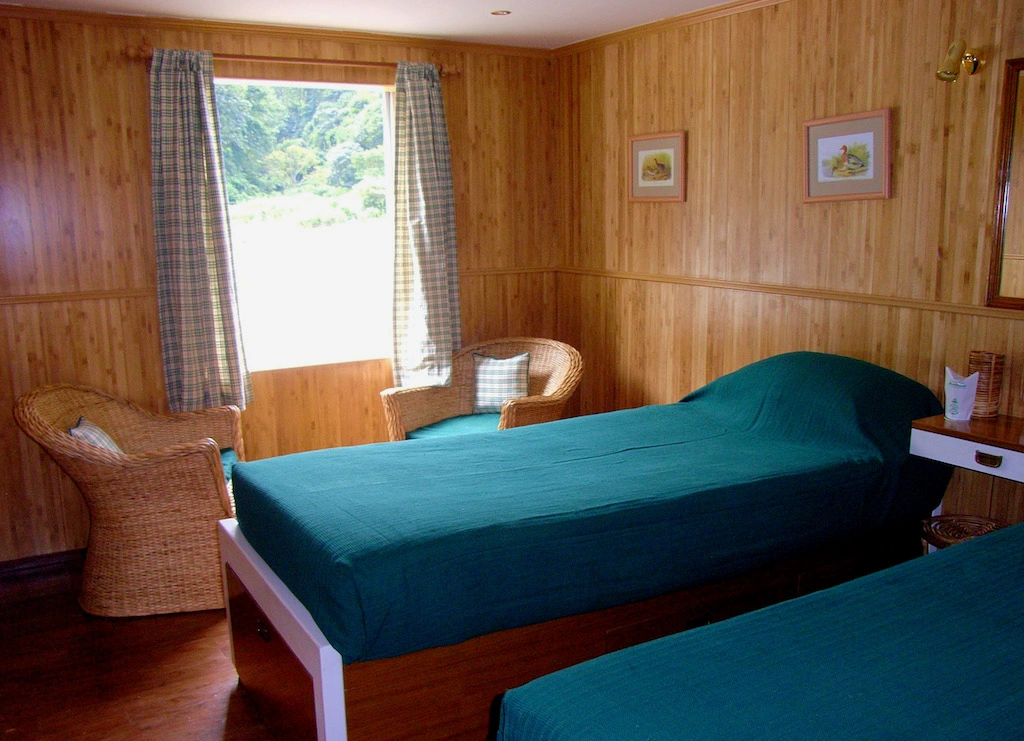
All 12 luxuriously appointed cabins had all the modern amenities that a discerning guest would look forward to. Along with air conditioners, each cabin was equipped with a shower cubicle and the interiors was designed ethnically with a harmonious blend of bamboo and wood. I especially liked the indigenously manufactured rattan chairs for their comfort. The cabins being on the Upper Deck meant that one had access to the panoramic riverside views from the comfortable confines of the cabins viz-a-viz the spacious sliding windows.
I was ushered into the well-stocked bar on the Upper Deck, where the choicest of liquors and spirits was readily available. As far as the cuisine is concerned, it can range from the very best of Assamese to the nouveau Indian and Continental.
Our first stop was at the medieval city of Sibsagar. In the days of yore, Sibsagar was a military bastion of the mighty Ahom rulers who ruled supreme for more than 600 years. Sibsagar is one of Assam’s principal centres of tea and oil. It is here that the regional headquarters of the Oil and Natural Gas Commission is located.
Modern-day Sibsagar is a town that is rapidly developing into one of the most vibrant towns of Upper Assam. This charming town, also a District of the same name, has earned the distinction of having the highest number of oil fields in Assam.
After a leisurely bout of sightseeing in Sibsagar, we hopped again into Charaidew for our onward journey.
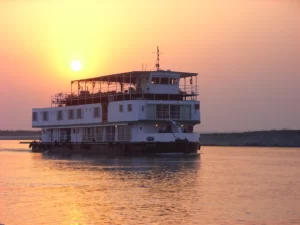
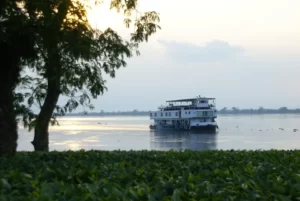
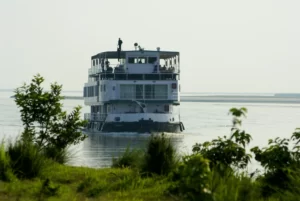
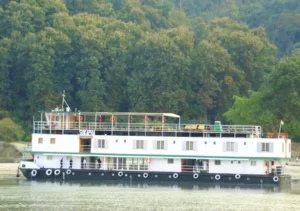
On Day 3, our vessel anchored at Majuli, the world’s largest riverine island. Here, we sampled the very best of Assam’s rich socio-religious tradition and heritage viz a viz the monasteries and witnessed the unique dance and drama performance enacted by the locals. According to our well-informed guide, Majuli has been short-listed by UNESCO as a World Heritage Site (Natural), and it is just a matter of time before Majuli is conferred with that coveted status. We cruised along the river for another two hours as we returned to our vessel before anchoring for our night halt.
Day 4 was primarily spent cruising, and to break the monotony of the cruise, we made a brief halt at Jamuguri, renowned for its fascinating tribal population. We spent an hour or so going on soft treks along the narrow winding village alleyways and chatting with the innocent village folks. The guests from the UK especially were taken aback by the richness of the tribal dwellers of Jamuguri, and the sight of the tribal womenfolk plying on their indigenous looms to produce exotically designed shawls was a kind of an eye-opener for them as it was for me.
By late afternoon, we had reached the outer contours of the world-famous Kaziranga National Park, the last remaining habitat of the rare and endangered One–horned Rhinoceros. One of our guests sighted the elusive Rhino, and there was a herd of spotted deer on a marshy stretch that grazed on the lush evergreen grassland. This was just the tip of the iceberg as far as the fascination with Kaziranga is concerned. The best was yet to come.
After a good night’s sleep, we woke up to a cacophony of bird sounds and, after freshening up, had breakfast on the Upper Deck. All the while, our vessel was gliding with the river’s flow.
Today (Day 5) was a big day for all of us as it would be our first real brush with Kaziranga’s wilderness. Two 4×4-wheel drive vehicles were waiting to transport us to the Western Range of the Kaziranga National Park.
There was a nip in the air as we rattled along the meandering jungle trail on our four-wheeled drive through the foggy landscape. As we travelled deep inside the forest, we became excited at the sight of untamed One-Horned Rhinos grazing in the grasslands of Kaziranga. As we traversed deeper inside the forest, we spotted species like the Hollock Gibbons, Capped Langurs (cute ones), Bristly Hares, Sloth Bears, Swamp Deer, Sambhar and Barasingha. If luck is on your side, you may spot the elusive Gangetic Dolphins that are a treat to watch.
After a fun-filled day out in the wilderness of Kaziranga, we returned weary and tired to our luxurious vessel. After freshening up and a stimulating pre-dinner drinks session, we savoured the best Assamese cuisine. That night, we all slept like logs, and the memories of the day’s eventful trip in the haunting wilderness of Kaziranga made us enthralled with the mystery that is Kaziranga.
Early next morning, as the vessel had covered enough nautical miles to be close to Kaziranga’s, Kaziranga’s Central Range meant more wildlife adventures awaiting us for the day. Apart from the early morning elephant rides and jungle safaris, visiting the neighbouring Tea Garden Estates was an enriching experience.
We undertook a leisurely trek along the border of Hathikuli tea estate, which belongs to Tata Tea, accompanied by a naturalist. The breathtaking sight of hundreds of tribal women plucking tea leaves onto their cane baskets hanging at their backs was straight out of the “Garden of Eden”.
The last three days were spent hopping and sightseeing in places like Tezpur, Guwahati and Sualkochi, each more interesting. While Tezpur, with its lush green tea gardens and proximity to Orang National Park, was terrific, so was the capital city of Assam – Guwahati, with the holy Kamakshya Temple perched atop the Nilachal Hills. For the quintessential Tantrik believers, this temple is the ultimate.
As the gateway city of North East India, Guwahati has come of age. Trendy multi-cuisine restaurants, neon-lit bars, deluxe hotels and a youth brigade constantly evolving to the demands of the new age are characteristic features of the city.
Guwahati has numerous centrally located markets for shopping, like the Fancy Bazaar, Paltan Bazaar, Ulubari, Ganeshguri and GNB Road. A popular haunt of the tourists to Guwahati is the Assam State Emporium, and we purchased a few Bamboo and cane products. The guests from the UK were more interested in the traditionally manufactured shawls, wall hangings and fancy Assamese hats.
Traveler’s Fact File:
Getting There:
- Guwahati, the capital of the state of Assam, is well connected by air, Rail and road to the rest of India.
- Spice Jet offers direct flights to Guwahati from Delhi and Kolkata.
- Guwahati is also well connected by Rail and is linked to Delhi by Rajdhani Express, North East Express, etc. A direct Express Train links Guwahati to Mumbai vis-à-vis the Dadar Express, Chennai by Coromandel Express, and Calcutta by Kamrup Express and Saraighat Express.
For any further information and reservations on long-distance river cruises in the Brahmaputra, please feel free to contact –
Assam Bengal Navigation Company,
Mandovi Apartments,
1st Floor, GNB Road, Ambari,
Guwahati – 781001, Assam,
India.
Telephone: +91-0361-2602186, 2602223, 2540995
E-mail: assambengal@rediffmail.com
Written By:
Subhasish Chakraborty
Travel Writer
B-14/148, Kalyani,
Dist: Nadia,
West Bengal-741235,
India.
Telephone: 91-033-25820092
E-mail: subhasish90@hotmail.com

